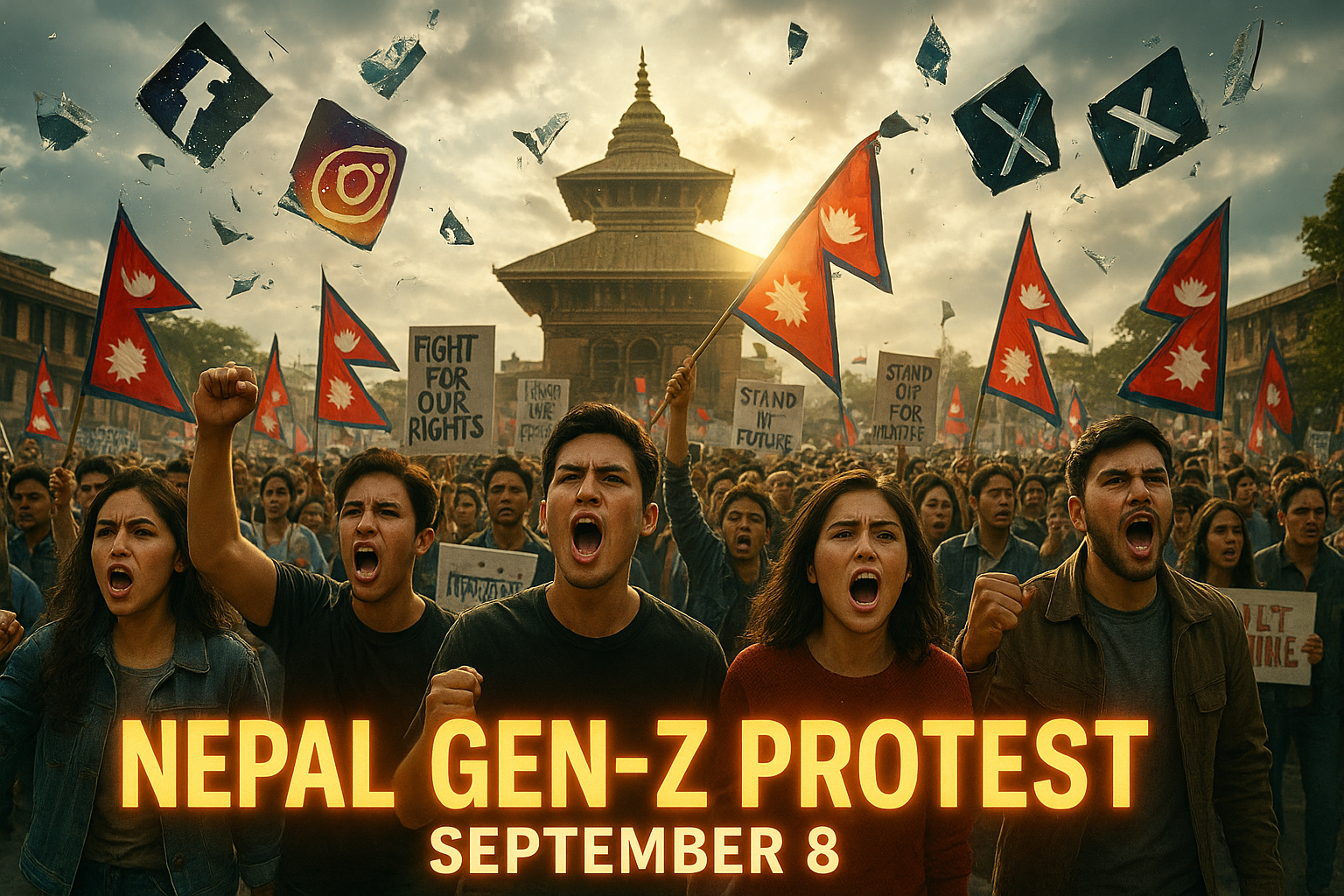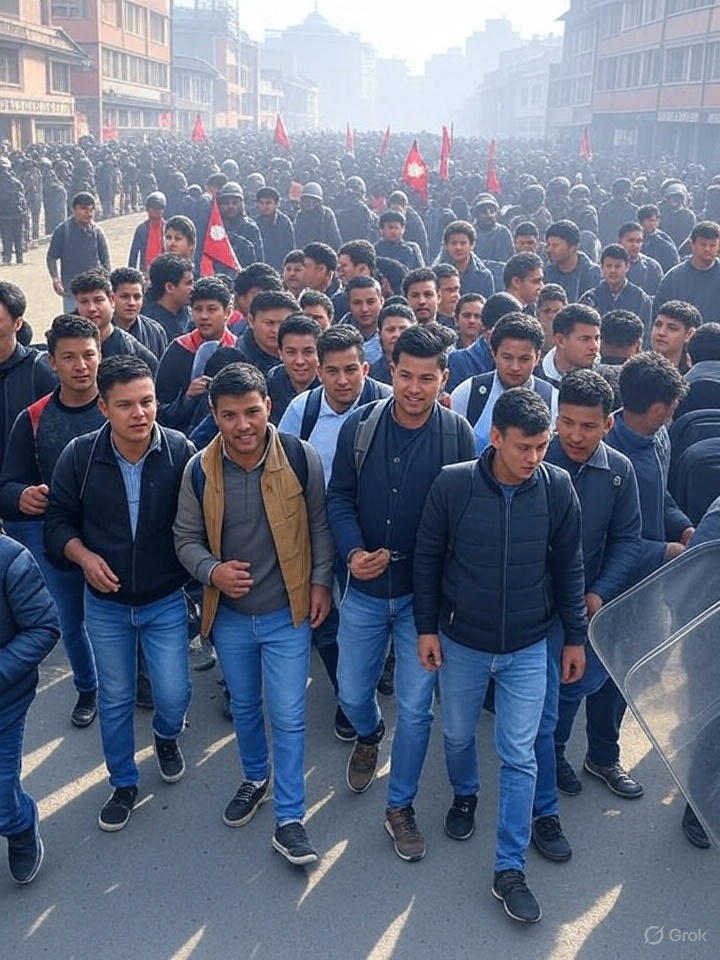Last Updated: September 8, 2025, 11:21 PM

Nepal Protest is on everyone’s mind these days. Streets in Kathmandu and other major cities are full of young people shouting slogans, holding banners, and demanding their voices be heard. But why exactly are so many youths angry and taking to the streets? This is not just about random anger—there are clear reasons that have triggered this massive uprising.
From social media bans that stop people from sharing their thoughts, to frustration over government decisions, the young generation feels their freedom is under threat. Jobs, education, and opportunities are also at stake. Many believe the government is ignoring their concerns.
In this blog, we will break down 7 key reasons why young people are protesting against the government in Nepal, so you can understand the real story behind the headlines.
Social Media Ban Angers Youth
One of the main reasons behind the Nepal Protest is the government’s ban on 26 popular social media platforms. Young people use these platforms not just for fun, but also for connecting with friends, sharing opinions, and learning new things. The sudden ban created a sense of shock and anger among Gen Z and millennials, as they feel their basic freedom to express themselves online is being taken away.
This restriction also affects online businesses, freelancers, and content creators, who rely on social media for income.
- Many youth feel helpless as their favorite platforms are no longer accessible.
- The ban has become a symbol of government control over freedom of speech.
Freedom of Expression Under Threat
The Nepal Protest highlights that citizens feel their freedom of expression is being limited. Young people believe they should be allowed to speak, share opinions, and protest peacefully without fear of punishment.
When people feel they cannot express themselves, frustration grows. This has fueled the anger seen in the streets during the protests.
- Activists say the government is ignoring citizens’ basic rights.
- Online discussions and debates about social issues are now blocked, adding to dissatisfaction.
Youth Frustration and Participation
Young people make up a large portion of Nepal’s population. Their voices are often ignored in government decisions. The Nepal Protest reflects the frustration of this group. They want their concerns heard, especially regarding policies that directly affect them, like education, jobs, and digital freedom.
Participation in protests is also a way for youth to show unity and strength.
Participation in protests is also a way for youth to show unity and strength.
- Streets are filled with students and young professionals demanding attention.
- Youth see protests as a tool to force the government to listen.
Lack of Government Transparency
Another reason fueling the Nepal Protest is the lack of clear explanation from authorities. The government did not provide proper reasoning for banning social media platforms. This has left citizens confused and mistrustful.
When decisions are made without transparency, people feel ignored. This lack of communication has made citizens even angrier, causing protests to grow larger.
When decisions are made without transparency, people feel ignored. This lack of communication has made citizens even angrier, causing protests to grow larger.
- Citizens demand explanations for policies that impact their daily lives.
- Social media ban without clarity is seen as unfair and arbitrary.
Economic Impact on Businesses
The Nepal Protest is not just about freedom of speech; it also affects the economy. Many young people run small businesses online, work as freelancers, or depend on social media to earn money.
With the ban in place, these income sources are suddenly blocked. This creates financial stress, making youth feel that their future and livelihoods are at risk.
With the ban in place, these income sources are suddenly blocked, creating financial stress. Youth feel that their future and livelihoods are at risk.
- Online entrepreneurs cannot reach customers, impacting their earnings.
- Students and part-time workers feel trapped as opportunities vanish.

Political Tensions and Opposition Support
Political conflicts and opposition parties have played a role in escalating the Nepal Protest. The ban on social media has been used by activists and opposition leaders to criticize the government. This has rallied more people to the streets.
Protests gain momentum because multiple groups unite for the same cause. The issue becomes more than a social media ban; it turns into a national movement.
- Protests gain momentum because multiple groups unite for the same cause.
- The issue becomes more than a social media ban; it turns into a national movement.
Rapid Mobilization Through Alternative Channels
Despite restrictions on social media, young people have quickly organized protests using alternative platforms and word-of-mouth. The Nepal Protest shows how technology and social networks help spread information even under government limitations.
Protesters use messaging apps, local networks, and offline coordination to mobilize crowds across cities. This rapid organization makes the movement stronger and more visible.
Protesters use messaging apps, local networks, and offline coordination to mobilize crowds across cities. This rapid organization makes the movement stronger and more visible.
- Even with some platforms blocked, communication among protesters remains active.
- Youth-led initiatives inspire more people to join the movement.
- The Nepal Protest is mainly about the government banning 26 social media platforms.
- Young people feel this decision limits their freedom of speech and affects jobs, education, and daily communication.
- Young people use social media the most for learning, earning, and expressing themselves.
- They feel ignored in government decisions, so they are taking the lead in the Nepal Protest.
- The ban impacts freelancers, small businesses, and content creators who depend on social media to earn money.
- Many have lost opportunities, which is why the Nepal Protest is also about jobs and income.
- No, the Nepal Protest is also about freedom of expression, lack of government transparency, youth frustration, and political tensions.
- Social media ban is just the starting point.
- Protesters are using alternative apps, messaging services, and offline networks.
- Despite the ban, word-of-mouth and youth coordination keep the Nepal Protest growing across the country.
- People want the government to remove the ban on social media, protect freedom of expression, and involve youth in important decisions.
- The Nepal Protest is a demand for more transparency and fairness.
